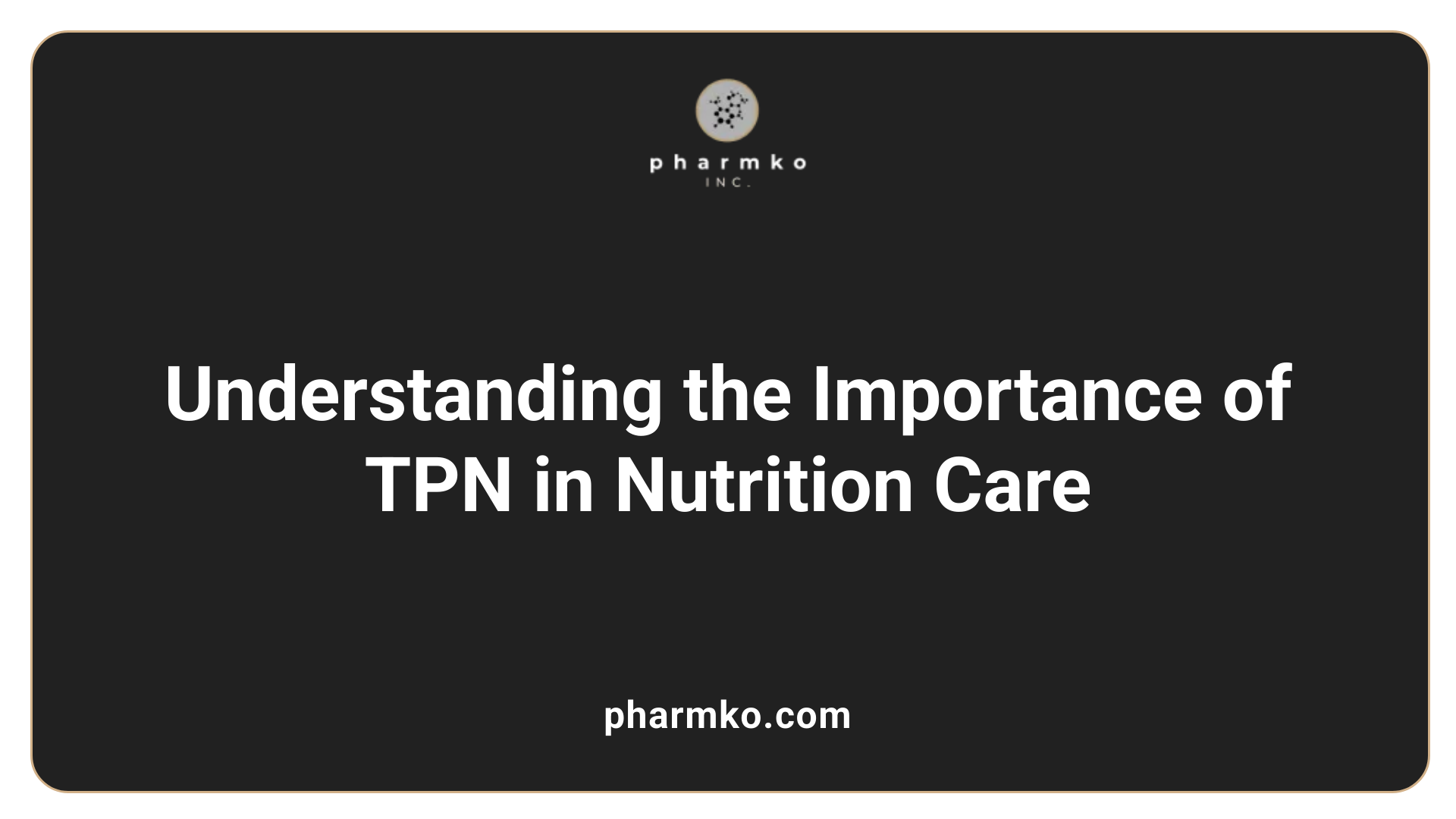Understanding the Differences Between Standard and Customized TPN Formulations

Introduction to Total Parenteral Nutrition (TPN)
Total Parenteral Nutrition (TPN) serves as a critical medical intervention for patients unable to derive nutrition from oral or enteral routes. By delivering essential nutrients directly into the bloodstream, TPN provides life-sustaining support for individuals with nonfunctional gastrointestinal systems. As clinical requirements vary, understanding the nuances between standard and customized TPN formulations is vital for healthcare professionals striving to optimize patient outcomes and ensure nutritional adequacy across different medical settings.
The Role of TPN in Clinical Nutrition

What is Total Parenteral Nutrition (TPN) and when is it used?
Total Parenteral Nutrition (TPN) is a critical medical intervention designed to provide all nutritional needs intravenously for patients who are unable to consume food due to various health conditions. This method bypasses the gastrointestinal tract entirely, delivering nutrients directly into the bloodstream.
TPN is essential in several situations, particularly when oral or enteral feeding cannot meet a patient's nutritional needs. It is often employed in cases such as:
- Chronic Intestinal Conditions: Patients suffering from chronic conditions like intestinal failure, bowel obstruction, or severe malabsorption are prime candidates for TPN.
- Post-Surgery Recovery: Following major surgeries, especially those affecting the gastrointestinal tract, patients may require TPN to ensure adequate nutrition during recovery.
- Critical Care: Critically ill patients with high nutritional demands benefit significantly from TPN, as it can provide essential nutrients tailored to their specific metabolic needs.
- Severe Vomiting or Diarrhea: Individuals who experience persistent vomiting or diarrhea may not retain nutrients effectively, necessitating the use of TPN.
Each TPN formulation is tailored to meet individual patient needs, often including a mix of carbohydrates, amino acids, lipids, vitamins, and minerals. Close monitoring is essential, as TPN can be associated with risks such as metabolic imbalances and infections. Therefore, careful assessment and continuous adjustments based on lab results help optimize patient outcomes and minimize complications.
Standard TPN Solution Composition

What are the components of a standard TPN solution?
A standard TPN (Total Parenteral Nutrition) solution consists of various macronutrients and micronutrients tailored to meet the individual needs of patients. The major components include:
- Carbohydrates: Usually supplied in the form of dextrose monohydrate, carbohydrates account for 60% to 70% of total calories in the solution.
- Proteins: Provided as amino acids, these are customized to meet varying needs, generally ranging from 0.8 to 2 grams per kg of body weight daily, depending on the patient's condition.
- Fats: Delivered through lipid emulsions, fats contribute approximately 25% to 40% of caloric intake.
- Water: This is a significant component, making up 70% to 85% of the total TPN mixture, essential for hydration and drug solubility.
- Electrolytes: Important electrolytes such as sodium, potassium, and magnesium are included to help maintain physiological balance and prevent imbalances.
- Vitamins and Minerals: A variety of essential vitamins and minerals are also incorporated into the TPN formula to support metabolic functions and overall health.
Overall, the composition of TPN is highly individualized, taking into account the patient's current health status, medical history, and specific nutritional requirements, ensuring that all essential nutrients are adequately provided to support recovery and maintain health.
Customized vs. Standard TPN: Key Differences

What are the key differences between standard and customized TPN formulations?
The differences between standard and customized total parenteral nutrition (TPN) formulations primarily revolve around composition and flexibility. Customized TPN solutions are individually crafted to meet the unique nutritional requirements of each patient. This tailoring process takes into consideration the patient's specific medical conditions, metabolic needs, and laboratory results. For example, a critically ill patient may require a higher concentration of protein and calories, leading to a bespoke formulation that addresses those requirements.
On the other hand, standard formulations, such as Clinimix, offer a set, fixed nutrient composition. These preformulated solutions typically contain specific amounts of macronutrients, including amino acids, carbohydrates, and fats, which cannot be altered. As a result, while Clinimix can efficiently support many patients, it may not be adequate for those with highly specialized nutritional needs.
How do storage and contraindications differ between TPN types?
The storage conditions for TPN solutions also differ significantly. Standard TPN formulations like Clinimix are designed for convenience, allowing them to be stored at room temperature, which simplifies logistics in acute care settings. Conversely, customized TPN must be refrigerated to maintain its stability and efficacy, underscoring the complexity associated with their preparation and use.
Contraindications between the two types of formulations vary as well. While standard TPN solutions may present risks for patients with specific metabolic issues or hypersensitivities, customized TPN formulations also have contraindications rooted in the individual patient's conditions and their metabolism capabilities. Hence, a meticulous evaluation by the healthcare team is essential before initiating either solution, particularly for patients with unique health challenges.
| Aspect | Customized TPN | Standard TPN (Clinimix) |
|---|---|---|
| Flexibility | Tailored to individual needs | Preformulated with fixed composition |
| Storage Requirements | Refrigerated | Room temperature |
| Contraindications | Varies per patient conditions | Specific metabolic issues |
| Preparation | Labor-intensive | Quick and convenient |
| Nutritional Coverage | Highly specific | General coverage |
In conclusion, when considering TPN options, it is critical to weigh the flexibility and storage characteristics alongside the specific contraindications associated with each formulation.
Complications Associated with TPN Therapy

What complications are associated with Total Parenteral Nutrition (TPN)?
Total parenteral nutrition (TPN) is a life-saving intervention for patients unable to obtain nutrition through oral or enteral routes. However, it comes with a range of complications that require vigilant monitoring and management.
Metabolic Abnormalities:
Patients receiving TPN commonly experience metabolic issues, such as hyperglycemia and electrolyte imbalances, affecting about 90% of recipients. These abnormalities necessitate regular blood glucose monitoring and electrolyte assessments to adjust the TPN formulation appropriately.
Infection Risks:
One of the primary concerns with TPN is the risk of catheter-related infections. Central line-associated bloodstream infections (CLABSIs) are particularly prevalent due to the long-term intravenous access required for TPN. Strict aseptic techniques during catheter insertion and maintenance are vital for minimizing infection risks.
Thrombosis:
The presence of intravenous lines used for TPN can increase the risk of thrombosis in blood vessels. Routine checks for proper line placement and function help prevent complications related to clot formation.
Hepatic Complications:
Prolonged TPN can lead to hepatic complications, such as fatty liver disease and cholestasis, affecting an estimated 15% to 40% of patients. Regular liver function tests are recommended to monitor liver health during TPN.
Refeeding Syndrome:
For patients with significant malnutrition, refeeding syndrome poses a critical risk. This syndrome can induce severe metabolic disturbances, characterized by electrolyte shifts, thus requiring careful reintroduction of nutrition and ongoing monitoring of electrolytes and vital signs.
In summary, the complications associated with TPN therapy are numerous and can significantly impact patient safety and recovery. Effective management strategies involve regular monitoring, individualized adjustments to nutrition formulations, and adherence to strict infection control practices.
Types and Comparisons of Parenteral Nutrition
What are the different types of parenteral nutrition and how do they compare?
Parenteral nutrition is a critical medical intervention for delivering nutrition directly into the bloodstream, bypassing the gastrointestinal tract. It primarily includes two types: Total Parenteral Nutrition (TPN) and Partial Parenteral Nutrition (PPN).
Total Parenteral Nutrition (TPN)
- Provides complete nutritional support.
- Ideal for patients who cannot utilize their digestive system at all.
- Customized formulations based on specific metabolic needs and clinical history.
- Typically delivered via central venous catheters for long-term use, ensuring access to a larger vein.
Partial Parenteral Nutrition (PPN)
- Supplements nutrition while allowing for some oral intake.
- Generally a lower concentration of nutrients compared to TPN.
- Administered through peripheral veins, suitable for short durations, usually up to 10 days.
Administration methods
When it comes to administration methods, TPN and PPN have distinct approaches:
| Method | Nutritional Support | Administration Route | Duration |
|---|---|---|---|
| TPN | Complete nutrition | Central line | Long-term |
| PPN | Partial nutrition | Peripheral vein | Short-term |
While TPN is crucial for patients with severe gastrointestinal issues, PPN can support those who still have some dietary intake capabilities. Both methods carry risks, including possible infections or complications from catheter placement, reinforcing the need for vigilant management.
Administration Guidelines for Nurses
What are the guidelines for TPN administration for nurses?
The guidelines for TPN (Total Parenteral Nutrition) administration focus on the critical need for intravenous nutrition in patients who cannot absorb nutrients via their gastrointestinal tract. Nurses play a vital role in this process, starting with a comprehensive assessment of the patient’s nutritional needs and confirming proper venous access.
Key Steps in TPN Administration
- Preparation and Access: Utilize strict aseptic techniques when preparing the TPN solution. Ensure that a central venous catheter is in place for TPN delivery, as it allows for the higher concentrations of nutrients required.
- Monitoring Vital Signs: Regularly check vital signs before and during the infusion to identify any signs of complications.
- Electrolyte and Glucose Monitoring: Conduct daily blood tests to monitor electrolyte levels, glucose, and liver function. This helps prevent complications such as refeeding syndrome or hyperglycemia.
Documentation and Patient Safety
Careful documentation is essential. Nurses must record:
- The infusion's starting time and duration
- Any adverse signs or symptoms during TPN administration
Emphasizing patient education is also crucial. Providing information about Home Parenteral Nutrition (HPN) can aid patients in their discharge planning, ensuring they continue to receive proper nutritional care at home.
In conclusion, adherence to these guidelines not only enhances TPN administration safety and effectiveness but also contributes to better patient outcomes.
The Economics of TPN Formulations
Cost Comparison Between Standard and Customized TPN
The economic implications of parenteral nutrition (PN) formulations can significantly influence healthcare decision-making. Recent evaluations have indicated that standardized total parenteral nutrition (TPN) formulations tend to be more cost-effective than custom-made versions. For instance, the average cost for standardized PN is approximately $61.06, while custom formulations come in at around $57.84. However, it’s essential to recognize that while standardized solutions are less costly, they may not always meet the specific protein requirements necessary for certain patient populations.
Preparation Time and Resource Use
In terms of resource utilization, preparation time is a crucial factor. Pharmacy staff typically require about 20 minutes to prepare standardized PN, in contrast to 80 minutes for custom PN formulations. This substantial difference underscores the increased workload and resource demands associated with tailoring TPN to individual patient needs.
Considerations for Use
Standardized formulations are likely to deliver adequate caloric intake for many patients, yet they may fall short in meeting higher protein goals. For example, only 63% of patients on standardized PN reached their highest protein intake target, compared to 92% in the custom group. Additionally, standardized formulations have been linked with a higher incidence of hyponatremia, which is critical to consider in patient outcomes.
| Factor | Standardized TPN | Customized TPN |
|---|---|---|
| Average Cost | $61.06 | $57.84 |
| Preparation Time | 20 minutes | 80 minutes |
| Percentage Achieving Caloric Targets | Similar rates | Assess based on individual needs |
| Frequency of Hyponatremia | Higher incidence | Lower incidence |
Understanding both the costs and preparation time involved in TPN formulations allows healthcare providers to make better-informed decisions regarding patient care and resource allocation.
Customized TPN Clinical Applications
Benefits in critically ill and special needs patients
Customized total parenteral nutrition (TPN) plays a vital role in supporting critically ill patients and those with special nutritional needs. For individuals who cannot process food orally or whose gastrointestinal systems are nonfunctional, tailored TPN formulations ensure that their specific metabolic requirements are adequately met. This individualized approach is particularly crucial in settings such as intensive care units, where patients often experience severe stress and require precise nutrient balances.
Critical patients may have varying protein and caloric needs based on their illness severity, organ function, and nutritional status. Custom TPN can adjust the distribution of carbohydrates, fats, proteins, vitamins, and electrolytes to match these fluctuating requirements, thereby optimizing their recovery process.
Therapeutic advantages over standard TPN
When comparing customized TPN to standardized formulations, several therapeutic advantages emerge. Customized solutions can better meet individual protein intake goals, essential for muscle preservation and repair during recovery. For instance, studies indicate that while standardized formulations efficiently meet caloric needs, they may fall short in delivering the required protein. Customized TPN formulations can thus enhance overall nutrient delivery, especially important for patients requiring high protein content.
Moreover, tailored TPN can also minimize complications, such as refeeding syndrome and metabolic imbalances, by providing closely monitored and modified dosages. By using daily lab tests to adjust the TPN composition, healthcare professionals can swiftly respond to any changes in a patient's condition, reinforcing the importance of personalized nutrition therapy.
| Aspect | Customized TPN | Standard TPN |
|---|---|---|
| Nutritional Personalization | Tailored to specific patient needs | Fixed formulations |
| Protein Delivery | Higher likelihood of meeting protein goals | Lower efficacy in achieving protein intake |
| Cost and Efficiency | Generally higher cost, requires more effort | More cost-effective formulation |
| Complication Prevention | Reduced risk via tailored adjustments | Risk of hyponatremia |
Nutritional Monitoring in TPN Therapy

Importance of Regular Assessments
Monitoring is crucial in total parenteral nutrition (TPN) therapy as it ensures that patients receive adequate nutritional support tailored to their specific needs. Regular assessments help in identifying potential complications early, such as refeeding syndrome or hyperglycemia, which can significantly affect patient outcomes.
Health professionals, including dietitians, pharmacists, and nurses, routinely evaluate the patient’s nutritional intake against their needs, considering factors like stress levels, organ function, and metabolic rates. This multidisciplinary approach helps adjust TPN formulations as necessary, ensuring that patients maintain their caloric and protein goals.
Adjustments Based on Lab Results
Lab results play a vital role in guiding TPN therapy adjustments. Blood tests can reveal essential markers such as electrolyte levels, liver function, and protein status, allowing healthcare providers to make informed decisions about the nutritional composition of TPN. For instance, if laboratory results indicate low sodium levels, the TPN formulation can be modified to increase sodium content accordingly.
In critically ill patients, daily adjustments might be necessary to accommodate rapid changes in their condition. Thus, close monitoring and regular lab work are essential for optimizing nutrition support and minimizing the risk of complications.
Overall, thoughtful nutritional monitoring is the backbone of effective TPN therapy, addressing individual patient needs while ensuring safety and efficacy throughout their treatment.
Standard TPN in Acute and Critical Care
Use Cases for Standardized Solutions
Standardized TPN formulations have emerged as a practical solution for patients in acute and critical care settings. They are particularly beneficial for individuals who require nutritional support but do not need the extensive customization that bespoke TPN provides. Standard formulations can simplify the nutritional delivery process, reducing preparation time from 80 minutes for custom solutions to just 20 minutes for standardized ones.
This time efficiency allows healthcare providers to allocate resources more effectively. Standardized TPN can be utilized in patients who have similar metabolic requirements, thus ensuring adequate caloric intake without the complexities involved in custom formulations. Patients suffering from bowel obstructions or recovering from major surgeries often find themselves in need of such efficient, straightforward nutritional interventions.
Study Findings on Caloric Delivery
Recent studies have explored the effectiveness of standardized versus custom TPN in meeting patients’ nutritional goals. The research indicates that standardized solutions can effectively meet caloric needs, showing no significant differences in achieving estimated caloric requirements compared to bespoke formulations. However, the data also highlights a downside: patients receiving standardized TPN were less likely to meet their protein intake goals. Specifically, only 63% achieved their highest protein intake goal compared to 92% of those on tailored solutions.
Additionally, a higher incidence of hyponatremia was observed in patients on standardized formulations (37%) versus those on custom TPN (14%). This suggests that while standardized TPN is a cost-effective option for delivering sufficient calories, care must be taken to monitor protein intake and electrolyte levels to mitigate potential risks.
Safety Considerations for TPN
Preventive measures and risk management
Safety in Total Parenteral Nutrition (TPN) administration is paramount due to potential complications. Preventive measures include meticulous patient assessment, focusing on factors like medical history, nutritional needs, and expected duration of use. This assessment informs whether TPN is indeed necessary and the appropriate formulation.
Monitoring is crucial, as complications can arise, such as infections, metabolic imbalances, and hyperglycemia. Health professionals must routinely check laboratory values to adjust nutrient levels accordingly, minimizing risks like refeeding syndrome and electrolyte disorders.
Guidelines for safe administration
Guidelines for safe TPN administration involve a multi-disciplinary approach with dietitians, pharmacists, and nurses actively collaborating. Each TPN solution should be individualized, containing essential components like amino acids, glucose, and lipids tailored to patient needs.
Important steps include:
- Storing TPN solutions in the refrigerator to ensure stability before use.
- Assessing intravenous access carefully to avoid complications associated with central venous catheters.
- Implementing strict aseptic techniques during preparation and administration to reduce infection risks.
These measures promote patient safety and enhance the efficacy of nutritional support, making TPN a vital option for patients unable to achieve adequate nutrition orally.
Future Directions in TPN Formulation and Usage
Innovations in TPN Technology
The future of total parenteral nutrition (TPN) holds promising innovations aimed at enhancing patient outcomes and optimizing nutrient delivery. Advances in technology may lead to better monitoring devices that can track patient responses in real-time, adjusting nutrient infusions automatically based on metabolic needs. Smart infusion pumps and wearable health technology may lead to more precise administration of TPN, improving safety and efficiency.
Ongoing developments in standardized formulations continue to make TPN more accessible and cost-effective while maintaining nutritional adequacy. With rising awareness of personalized medicine, future formulations could harness genetic data to tailor TPN solutions, ensuring optimal nutrient delivery among diverse patient populations.
Potential Research and Development Areas
Research is expanding into alternative nutrient sources and the role of gut microbiota in TPN patients. Understanding how specific nutrients affect microbiome health may guide formulation enhancements, playing a critical role in preventing gastrointestinal-related complications.
Additionally, exploring the implications of TPN on long-term health, including impacts on liver function and metabolic pathways, will be essential. Studies could focus on the duration of use and its correlation with complications such as hyponatremia.
The development of novel amino acid compositions and lipid emulsions tailored to unique patient requirements may further enhance clinical outcomes, pushing the boundaries of what TPN can achieve.
Balancing Efficiency and Personalization in TPN
The decision between standard and customized TPN formulations depends on balancing the need for efficient nutrient delivery with the specific metabolic requirements of patients. While standard formulations offer consistency and cost-effectiveness, customized TPN provides tailor-made solutions critical for patients with unique nutritional challenges. Both approaches require careful consideration of patient conditions and available clinical resources, underscoring the importance of continued research and innovation in parenteral nutrition to enhance patient care outcomes.
References
- Parenteral Nutrition: What it Is, Uses & Types - Cleveland Clinic
- Clinimix vs. TPN: How Are They Different?
- Parenteral Nutrition Overview - PMC - PubMed Central
- Standardized versus custom parenteral nutrition: impact on clinical ...
- Comparison of standard versus tailored parenteral nutrition in ...
- Standardized versus custom parenteral nutrition: impact on clinical ...
- 8.8 Total Parenteral Nutrition (TPN) – Clinical Procedures for Safer ...
- 8.8 Total Parenteral Nutrition (TPN) - eCampusOntario Pressbooks
- The ultimate nutrition support guide for dietitians


































































































